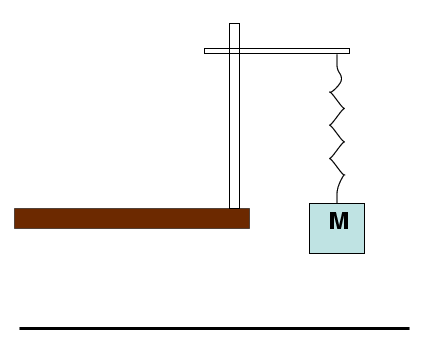The force exerted by a spring
If you try to stretch a spring, it will pull back against
you.
The farther you stretch the spring,
the harder it pulls back.
Can you make this simple description more quantitative?

- Acquire one small silver spring. Measure its mass and its
length as it lies horizontally at rest on the table.
- Arrange clamps and bars as shown in the diagram above so that you
can hang the spring from a horizontal bar.
Measure the length of the spring as it hangs by itself;
call this Lvert.
- Place 7 various weights, ranging from 0 to 150 grams, on the
bottom of the spring. Measure the length
of the spring for each case.
Compute the distance the spring has stretched
from Lvert.
Include uncertainties in this "distance stretched".
- Calculate the force exerted by the spring in each case.
Make a neat table of all your measurements and calculations.
- Make a graph on good graph paper.
The graph should show force exerted by the spring
as a function of the distance by which the spring
has been stretched.
- Use your graph to compute the "spring constant" or "force constant"
of your spring. Include uncertainties, and make
sure the units of your values make sense.
- Walk around and talk to at least 3 other groups.
Write down their spring constants (with uncertainties)
and compare them to yours.
Are all the springs in class today "identical"?
Optional Extra
At the center table, I will set up a track
tilted at 15 degrees.
We will attach your spring to the track so that it
lies along the track,
and then attach to the lower end
a cart of mass m (I'll provide the
actual mass during the class period).
How long will your spring be when it comes
to rest, supporting the car on this tilted track?
Make a prediction.
If your prediction is you gain
within bonus points
------------------------------------------
+/- 3 cm +2
+/- 6 cm +1
------------------------------------------

